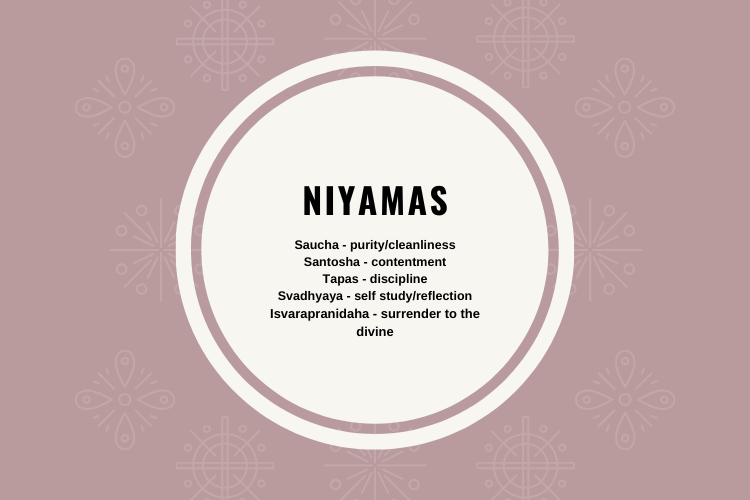
8 Limbs of Yoga – Part 2 – NIYAMA
Written by Vidya Venkateswaran
Niyama are the second limb of the Eight Limbs of Ashtanga Yoga as laid out by the Sage Patanjali in the Yoga Sutras. Niyama are positive duties or observances for healthy living that are at the core of yoga philosophy.
Niyama are guidelines to live a more intentional and conscious life both on and off of the yoga mat.

How do these translate into everyday life?
Saucha:
With regards to our yoga practice, this means we come to class having showered, treat the yoga space and fellow yogis with respect, clean our mat after our practice, and put things back into the right places after class. In our yoga practice, it is about using both sides of our body equally to generate Prana and rid the body of impurities.
In our daily life, we practice Saucha by keeping things clean and organised and simplifying our life to be as waste-free as possible.
Saucha is also about purifying the mind and heart. We can do this by developing positive attributes like love, kindness, compassion, and gratitude rather than desire, anger, delusion, greed, and envy. When the negative attributes are absent from the mind and the heart, we experience ease of spirit and the inherent sattvic nature of mind becomes predominant. We achieve clarity and are more reflective, responsive, and peaceful and are not envious of our fellow yogi who can perhaps do many more complex poses than us. We develop gratitude to have a practice we can come back to and take the peace we feel into the world.
Santosha:
Santhosha comes from Sanskrit: ‘Sam’ – completely/entirely and ‘tush’ – acceptance, the satisfaction which translates to complete acceptance or contentment.
It is an underlying characteristic of the mind that happiness is not dependent on an external source.
In our yoga practice, we can practice contentment by being present, intentional, and mindful in our practice. This means we don’t constantly compare our progress with our fellow yogis but instead we are accepting of our own practice.
In our life, we can be content by not chasing after material possessions or letting our happiness be driven by external sources. We should strive to be happy with what we have and realize that external sources can only provide temporary satisfaction.
Tapas:
The literal meaning of tapas is to ‘heat up’ or ‘cook.’ Tapas is self-discipline of having a practice that challenges us on a daily basis.
Tapas helps create resilience and grit both internally and externally.
Tapas is karma yoga, the yoga of action. In our yoga practice, tapas help us create a habit to practice. It allows us to move out of our comfort zone to attempt poses we usually avoid.
In our daily lives, tapas provides clarity, increase our willpower, and give us room to investigate which way we need to go.
Svadhyaya:
‘Sva’ means ‘self’ and ‘adhyaya’ means ‘study’.
A modern interpretation of svadhyaya is self-reflection.
In our yoga practice, svadhyaya allows us to examine our journey and how far we have come without ego, and without judgment. It encourages us to seek spiritual growth beyond asana practice.
Ishvarapranidhana:
Isvara pranidhana is surrender or devotion to God or the unknown. If we are able to surrender our individual ego/identity to God (our own higher self), if we can dedicate our lives to serving the God that resides within all beings, humans and non-humans alike can move beyond all feelings of separateness.
We can achieve this in our yoga practice by offering the results of our practice to the unknown without getting attached.
Similarly in our daily lives we need to understand that our actions affect not only us but other people and the environment.




No Comments